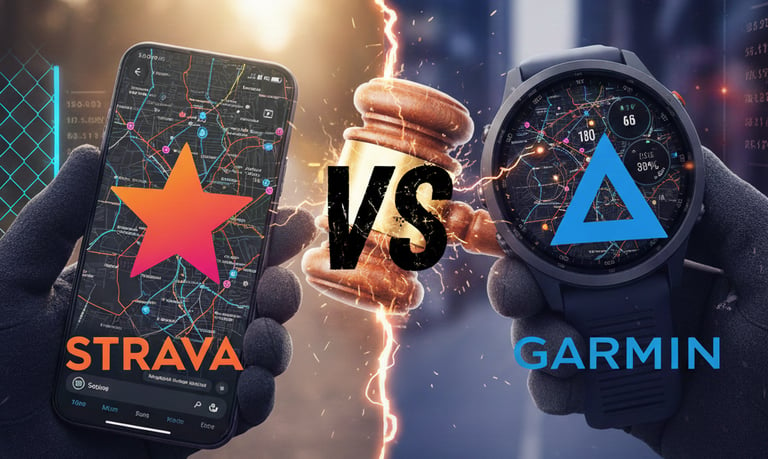Strava Sues Garmin: Patent Infringement Lawsuit Threatens Core Running Features
TOP STORIESELITE & INDUSTRY NEWS


The $1 Million Segment: Strava Sues Garmin in Patent Battle
Two of the biggest names in the running technology world are currently embroiled in an intense legal battle following a lawsuit filed by Strava against Garmin last week. For any runner who logs activities, checks segment leaderboards, or uses popularity-based route creation, this case is worth following closely.
Strava is suing Garmin for patent infringement, breach of contract, and unfair dealing/bad faith. The core of the complaint alleges that Garmin is copying or reusing Strava’s proprietary technologies—specifically the technology that powers popular features including segments, leaderboards, and popularity-based routing. In short, Strava contends that it invented these core concepts and Garmin is using them without permission.
In its complaint, Strava is seeking financial compensation (damages), attorney fees, and a permanent injunction, which could potentially force Garmin to stop selling devices that utilize the disputed technology.
The History of a Partnership
The lawsuit comes as a surprise to many, as Strava and Garmin have maintained a partnership since 2015. Their relationship was governed by a legal agreement, the Master Corporation Agreement, which allowed Garmin to display Strava segments directly on its devices.
Crucially, the agreement allegedly stipulated that Garmin could use the Strava segments only for Strava users and within strict limits. Strava now alleges that Garmin broke that agreement by developing and releasing its own versions of these features, naming them Garmin Segments and Garmin Trending Routing.
The Complexities of Patent Law
The patent infringement claims rest on Strava’s patents, which were secured around 2014. In intellectual property law, protection is defined by specific, numbered claims at the end of a patent, which function like property lines for the invention. The rest of the patent provides general descriptions and examples.
Experts suggest that even if Garmin’s features look functionally similar to Strava’s, the determining factor will be how Garmin’s technology operates. If Garmin’s algorithms process data differently or use unique logic "under the hood," this could be sufficient to avoid a finding of infringement. This is why complex patent lawsuits often hinge on technical processes rather than superficial design.
Online commentary suggests that obtaining patents for data-driven technologies was simpler in the early 2010s. Some observers question whether Strava’s patents should have been approved in the first place, noting that digital IP law is still evolving, leading to potential challenges to the validity of the patents themselves.
Why Now? Two Key Motivations
The timing of the lawsuit—nearly a decade after the initial agreement—has sparked speculation. Two primary theories have emerged:
Garmin’s Attribution Push: On July 1st, Garmin announced new developer guidelines requiring all partners, including Strava, to increase attribution (logo placement or data sourcing notes) starting November 1st. Garmin threatened to cut off API access for non-compliant partners, meaning automatic data syncing to platforms like Strava would end. This demand for more prominence likely prompted the legal counter-move from Strava.
Garmin’s Potential IPO: Unconfirmed reports emerged in mid-September that Garmin is planning for a potential IPO as early as 2026. Filing a major lawsuit that defends its intellectual property (IP) and data ecosystem could be a strategic move to boost investor confidence by demonstrating its seriousness about owning its innovation.
As of the filing date, Garmin has not yet filed its formal legal response, but its defense is widely expected to focus on the argument that its GPS logic and data processing methods do not infringe upon Strava’s protected technology.
The Stakes for Runners
For both companies, the stakes are immense. For Strava, the lawsuit is about defending its identity as the social network for athletes and the unique technology that drives its platform. For Garmin, the goal is to maintain the strength of its own ecosystem without dependence on external partners.
While the two companies may need each other (Garmin provides the data; Strava provides the community), the future relationship is uncertain.
Current Status: The lawsuit currently means little for runners; Garmin devices still sync automatically with Strava.
Worst-Case Scenario: If Strava wins, Garmin could be forced to remove or disable features like segments and popularity routing. Syncing could become limited, or Garmin may have to pay licensing fees, costs which could be passed on to users through higher device prices or increased subscription fees.
Best-Case Scenario: The two companies reach a settlement, sweep the details under the rug, and continue the partnership with new terms.
The running community has largely been vocal, with many pointing out the irony of Strava defending data ownership while relying heavily on data from partners. However, a significant number of runners have stated that if Garmin cuts off Strava, they would seek alternatives, prioritizing the community and social aspects of their fitness data.